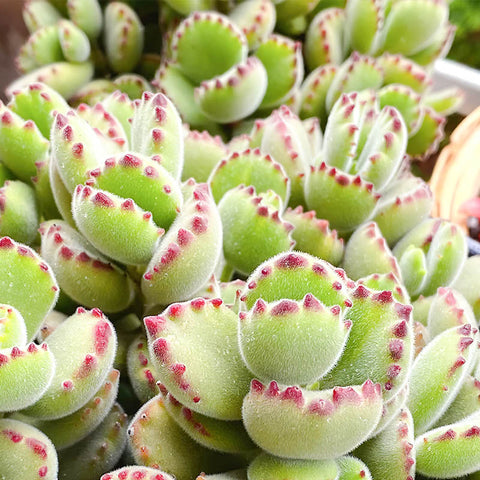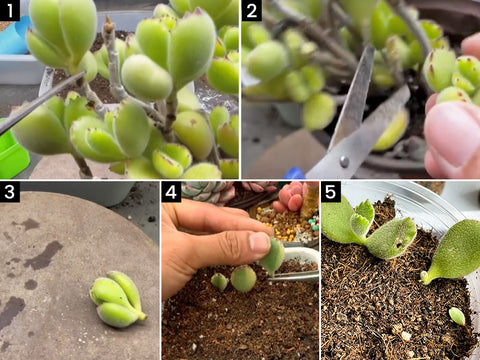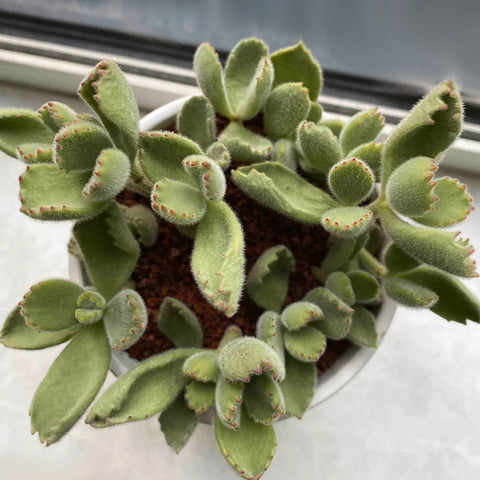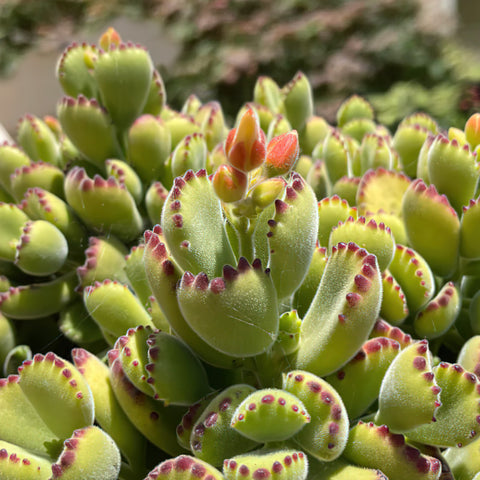Bear's Paw Succulent, scientifically known as Cotyledon tomentosa, is an adorable succulent from South Africa. The chubby green leaves of Bear's Paw feature red serrations at the top, growing in pairs and adorned with a layer of white fuzz, resembling the cute paws of a newborn bear.
Cotyledon tomentosa grows upwards, with its main stems gradually becoming woody, quickly adopting a shrub-like appearance. Whether planted in a garden or potted on indoor tabletops and windowsills, Bear's Paw Succulent is incredibly captivating during summer and autumn when it blossoms vibrant red flowers.
As a popular succulent, many beginners face challenges caring for Bear's Paw Succulent. This blog aims to provide you with this charming plant's most detailed care guide.
How to Care for Bear's Paw Succulent
Ample Sunlight
Bear's Paw Succulent thrives in abundant sunlight, ideally receiving at least 6 hours of direct outdoor light. When indoors, place it on an east-facing windowsill. Regularly rotate Bear's Paw Succulent to ensure even sunlight exposure, preventing weak and elongated growth in low-light conditions. Remember, adequate sunlight doesn't mean prolonged exposure; shield Bear's Paw Succulent from intense summer sun, providing morning sunlight and shade after noon, or using a sunshade to prevent leaf drop due to sunburn.

Optimal Temperature
Bear's Paw Succulent thrives in temperatures ranging from 18-24°C, indicating it's a soft succulent. Summer and winter pose challenges for Cotyledon succulents. In temperatures exceeding 35°C during summer, consider moving the succulent indoors or placing it in a shaded, well-ventilated outdoor space. If temperatures drop below 10°C in winter, move it indoors or to a greenhouse. The fleshy leaves of Bear's Paw Succulent are prone to frost damage in colder temperatures.
At the right temperature, the color of the small "fingers" at the top of Bear's Paw Succulent deepens, turning red. These adorable succulents may even grace you with red, bell-shaped flowers in autumn.

Watering Frequency
Assessing Bear's Paw Succulent's water needs is as simple as feeling its leaves. When well-hydrated, the leaves are plump and firm—water when the leaves appear wrinkled and feel soft. In well-ventilated conditions during spring and autumn, water approximately once a week, focusing near the base to avoid wetting the leaves and preventing fungal diseases. Alternatively, water from the bottom.
Adjust watering frequency in summer and winter. Recommend watering every 3-4 weeks with a reduced amount (about 1/3 of other seasons) to maintain vitality and reduce the risk of root rot. After summer, when Bear's Paw Succulent may look dehydrated, thoroughly water every 2-3 days for a week to restore fullness.
Soil and Pot
Like most succulents, Bear's Paw prefers well-draining soil. Opt for specialized succulent potting mix, adding 40%-60% perlite or Gritty Mix Rocks for enhanced drainage. Choose planter pots with drainage holes.
Propagating Bear's Paw Succulent
Due to leaf propagation challenges, replicating Cotyledon succulents is often done through stem cuttings. Follow these steps:
1. Select a fresh stem from the top or non-woody parts of Bear's Paw Succulent.
2. Use clean scissors to cut a section with 2-3 pairs of leaves.
3. Let the cut stems air-dry in a ventilated area for 1-2 days.
4. Gently insert the Bear's Paw Succulent stems into moist or dry soil.
5. Bear's Paw Succulent roots are slower than typical succulents, taking about a month. Avoid frequent touching during this period, allowing new roots to develop.

Common Issues with Bear's Paw Succulent
Why is my Bear's Paw Succulent losing leaves?
Like many succulents, leaf shedding in Bear's Paw Succulent is a natural metabolic process. Average leaf drop occurs at the base when leaves wither or during repotting. Transportation bumps can also cause minor leaf loss. Extensive leaf drops may signal distress, often in summer, due to prolonged exposure to high temperatures and intense sunlight. If this happens, move Bear's Paw Succulent to a shaded or more relaxed area. Healthy stems will sprout new leaves in autumn. To prevent this, find a shady spot for your succulent before summer, and avoid frequent watering to prevent root rot in humid conditions.

What do you do if Bear's Paw Succulent leaves are thin?
Thinner leaves in Bear's Paw Succulent suggest increased water. Thoroughly water the succulent approximately every week, and ensure it receives adequate light. A well-hydrated Cotyledon tomentosa displays plump, chubby leaves.

Why are Bear's Paw Succulent leaves drooping?
Despite watering, if Bear's Paw Succulent appears soft and unable to stand upright, consider the plant's age and sunlight exposure. Young stems may need to provide adequate support. Ensure Bear's Paw Succulent receives direct sunlight, promoting the formation of corky stems for upright growth.

Is it normal for Bear's Paw Succulent to have a smell?
Bear's Paw Succulent emits a unique, somewhat sticky odor, detectable by those with a sensitive sense of smell. Some find it fragrant, while others describe it as unpleasant. This distinct scent attracts pollinators. Bear's Paw Succulent is toxic and may draw pets, so exercise caution. There are 20 Toxic Succulents You Need to be Aware of.
What do the white stripes on Bear's Paw Succulent mean?
Congratulations, you may have acquired a Bear's Paw Variegated Succulent. This variant arises from natural genetic mutations, presenting white or light yellow stripes on the leaves.
Conclusion
With these informations, you should now have a better understanding of Bear's Paw Succulent preferences. Don't give up if you've faced setbacks or are currently navigating challenges. Cultivate more patience and let this fluffy, adorable Bear's Paw succulent become your steadfast plant companion.



























1 thought on “How to Care for Bear's Paw Succulent”
Suzie
My Bear Paw plant’s stems have turned woody. The leaves are quite small also. Should I just propagate new plants from the fleshy leaves or will cutting the stems back spur new growth?